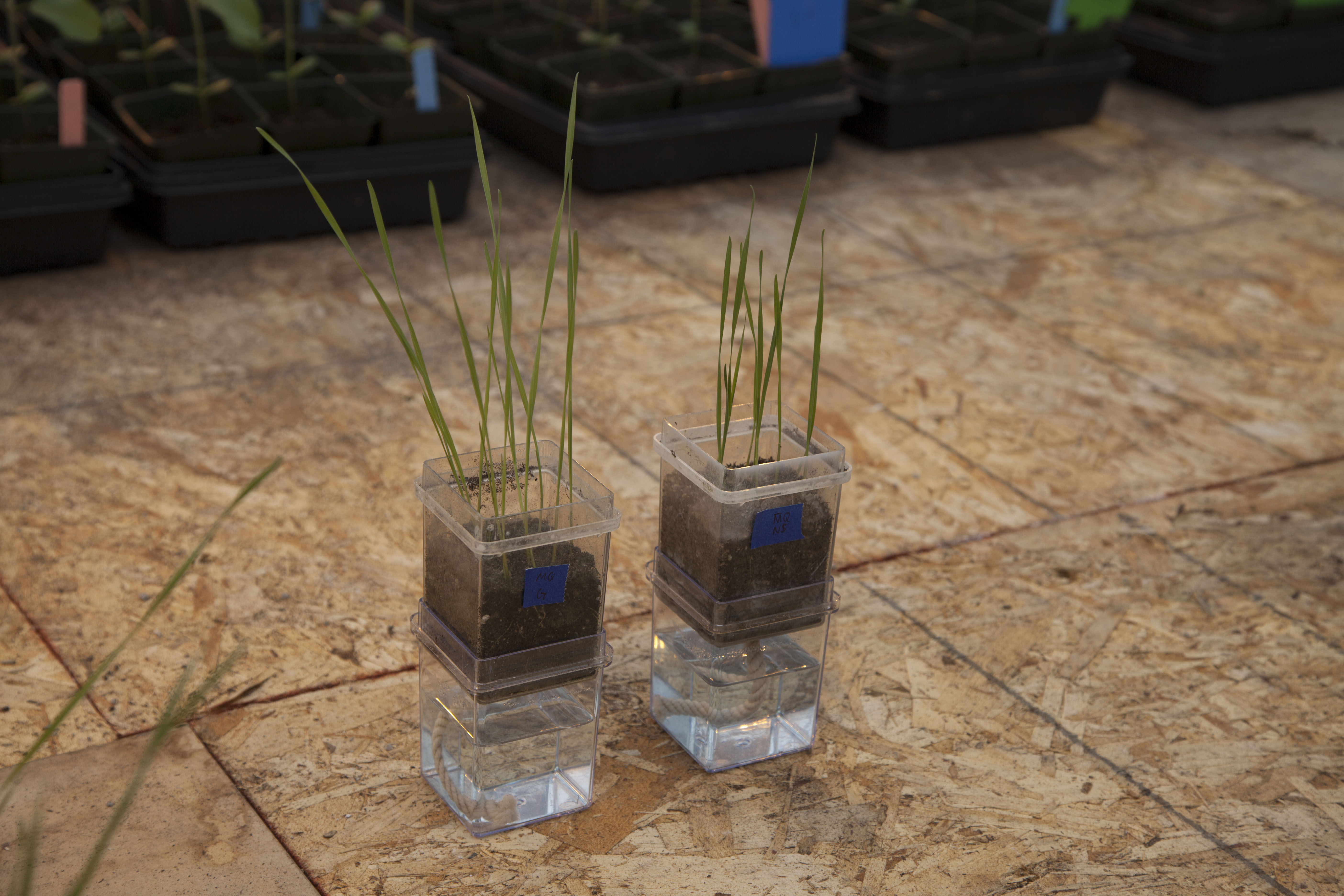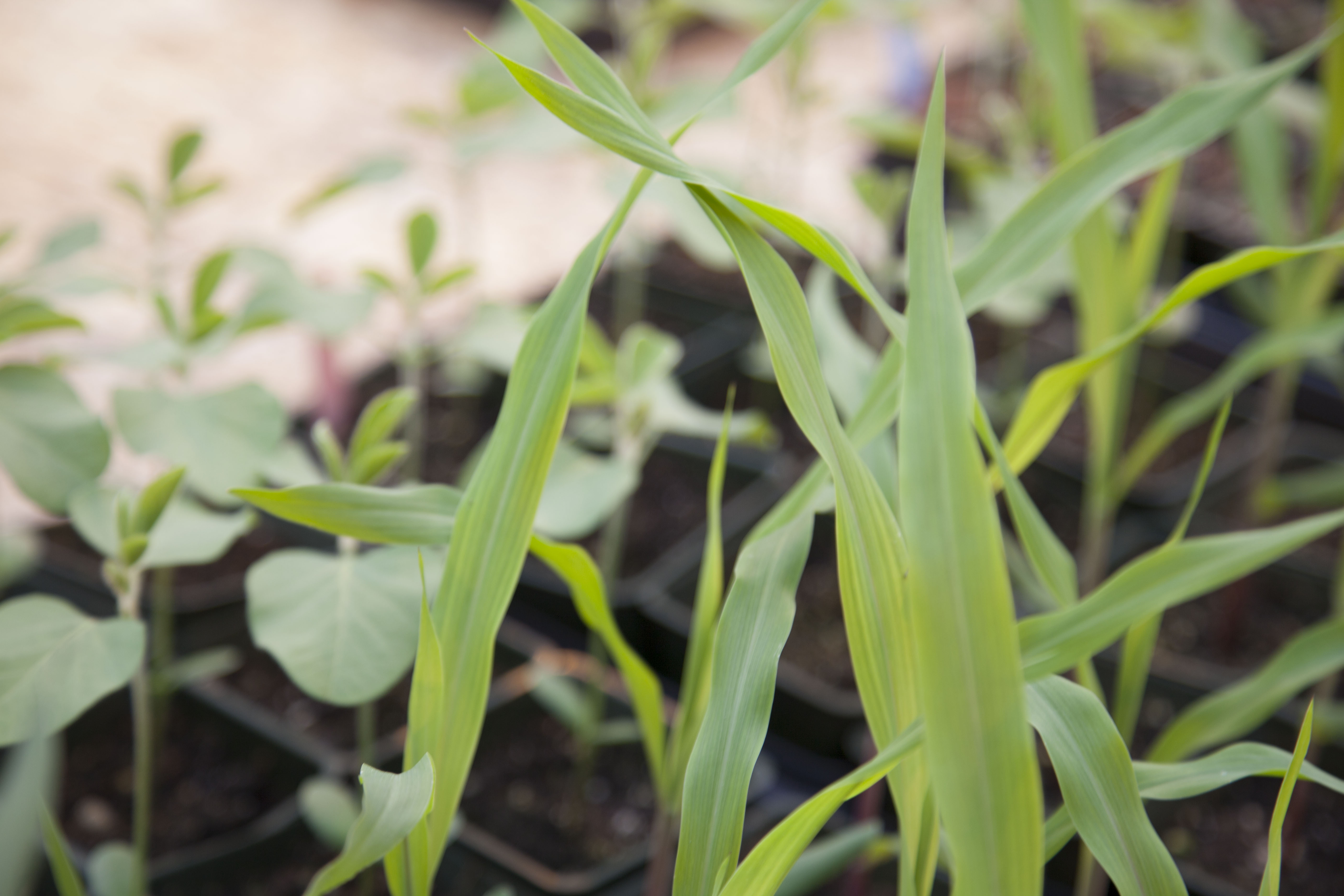Just east of the University of Washington campus, along a busy thoroughfare, behind a rundown strip of retail space, up a flight of rusty stairs, there’s a glass door. Inside, past a cramped office overflowing with books, a couple of computers, and a bare-bones kitchen, there’s a lab.
This, a hole in the wall on the north edge of Seattle, is where plants go to get superpowers.
And by superpowers, I mean a fungal infection. But trust me — this is like the radioactive spider bite of fungal infections.
It all started more than 15 years ago, when Rusty Rodriguez and Regina Redman, a husband-and-wife team of biologists, went to Yellowstone National Park to study the microbes living in hot geothermal soils. They wanted to understand how living things could survive such extreme temperatures — up to 145 degrees Fahrenheit, depending on the season.
But when they got there, something else surprised them. They found plants thriving in the very same geothermal soil, which geologists had always described as barren, Rodriguez says.
Curious, the couple took samples back to Washington, where they both worked for the U.S. Geological Survey, for analysis. And what they found was a nature-made technology that could replace — or at least supplement — genetic modification in protecting crops from climate change.
***
No plant is an island. That is, when you look at a plant, you’re not looking at a single organism, but rather a host organism full of bacteria, viruses, and fungi (plants – they’re just like us!).
According to the fossil record, fungi have been living symbiotically with plants for more than 400 million years. In fact, the ole fungus among us may have actually helped the first land plants transition out of water.
If you’ve ever taken an introductory biology class, then chances are you’ve already heard of at least one of these fungal friends — the mycorrhizae. These fungi live in and around plant roots, helping those plants absorb water and nutrients from the soil. Mycorrhizae are kind of the poster children of mutualistic symbiosis (not to be confused with parasitic symbiosis, which is more like what went down between you and that one roommate who ate all your food and never cleaned the bathroom).
[grist-related-series]
But there’s a lesser-known type of fungus that actually grows inside the bodies of most, if not all, plants, inhabiting the empty spaces between cells. Fungi that do this are known as endophytes, and they’re what Rodriguez and Redman found were the key to those plants surviving in Yellowstone.
Alone, neither the fungus nor the plants could survive temperatures higher than about 100 degrees F. But with their powers combined, they could somehow tolerate the extreme heat of geothermal soils. What’s more, the plants infected with these fungi seemed to require less water and nutrients to grow as much — if not more — biomass than those uninfected, while maintaining the same — or better — nutrient levels.
When Rodriguez and Redman tried infecting tomato and watermelon plants with the fungus, they found that both developed the same extreme heat tolerance within just 24 hours.
“It changes your concept of the normal Darwinian process of slow adaptation,” Rodriguez says, sitting at a cluttered bench in the Seattle lab. “This is something very different, but it’s also something that’s just been hugely overlooked by the vast majority of evolutionary biologists and ecologists and plant physiologists. There are a lot of people who study symbiosis, but it’s still a small subset of biological sciences.”
Soon after the Yellowstone discovery, Rodriguez and Redman traveled to other extreme environments in search of more miraculously thriving plants. And sure enough, inside every healthy plant growing where no sane plant should grow — whether in salty soil, drought-stricken soil, cold soil, even soil contaminated with heavy metals — they found endophytes.
“Pretty much now we know that if we go into habitats with native plants, and we can identify what the stresses are that those plants may be seeing,” Rodriguez says, “we know that there’s like a 99.9 percent chance there’s a fungus inside that plant that’s conferring tolerance to this stress.”

Wheat plants treated with endophytes (left) show more biomass growth than untreated plants (right).
How exactly those fungi work their magic, however, is a different story. Rodriguez explains it like this: When humans experience stress, we tend to manifest that stress physically, in the form of giant zits or head colds. Similarly, when plants experience stress, their metabolisms tend to get all out of whack. But with endophytes, it’s like they have a little voice inside saying: “Chill out. We’re gonna get through this, and here’s how.” Their environment is still harsh, but they just don’t stress out.
In reality, the fungi are somehow dramatically altering the gene expression of their host plant. How or which genes they alter is unclear, Rodriguez says, but he and his collaborators are currently trying to tease out the details.
“It’s unbelievable,” Rodriguez says. “I mean, there’s not that much fungus inside the plant, but it’s a hell of a communicator. It’s just really quite remarkable.”
They also know that the soil microbes around an infected plant are drastically different from the microbes around a non-infected plant, even if the two are only a few feet away.
“It makes a lot of sense in some ways, because microbes were the first things to develop on this planet. They never left the planet, so everything else had to develop and evolve within that construct. That’s why you’re full of bacteria. You have more bacteria than you even have human cells,” Rodriguez says. “Plants are exactly the same, except there, we can do more detailed experiments. Nobody complains, nobody screams — you can ask much more probing questions.”
***
By 2012, Rodriguez and Redman had done enough research on endophytes that it was time to either move on or go commercial, Rodriguez says. They opted for the latter, recognizing the potential boon endophytes could be for the agricultural industry in the face of climate change.
The following year, the couple moved their new company, Adaptive Symbiotic Technologies (AST), into its current space behind the retail strip near the University of Washington campus. This fall, AST will start selling Bioensure — a liquid spray that farmers can use to coat their seeds so that the fungi get into any emerging tissue.
Ultimately, Rodriguez hopes, this technology could be an alternative to genetically modified crops — many of which, he points out, work in the lab but fail in the field.
But Brian Murphy, a professor of botany at Trinity College Dublin, says that endophyte research has also experienced its fair share of troubles in the field.
“Many endophytes are tested in the lab and give very promising results, but they give inconsistent results in field situations,” Murphy wrote in an email. “They may be beneficial to one crop in a certain environment but not to another in a different environment. This has led to many disappointing outcomes from commercialization efforts involving partnerships between academia/research and industry.”
All the same, AST “may prove the exception,” he said.
The company has already done successful field trials in Michigan, California, North Dakota, Louisiana, and Texas. They’ve since expanded to hundreds of sites in an attempt to hit every soil type and climate zone in North America, except the Arctic. Most of their early work focused on rice, corn, soy, and wheat, but they’ve also begun testing other crops like sorghum and millet.
Rodriguez says that he expects the company to start publishing results from their field trials next year, but so far, the fungi seem to work their magic all over. During a particularly dry year in Michigan, for example, field trials for corn resulted in a staggering 85 percent increase in yield. The impact of the fungi decrease with improving conditions, but even under low stress conditions across multiple states, the company reported an average of 7 percent yield increase in corn. Rodriguez says that the spray’s success in multiple locations might have to do with the fact that the fungi live entirely inside the plant, rather than on its surface or in the soil.

Young corn plants treated with endophytes.
One reason why AST may be having so much success, Murphy said, is that the company has focused specifically on endophytes found in high-stress environments. Other researchers have tried testing endophytes from a variety of environments, he said, so it made sense that some of them failed in the field under high stress conditions. Murphy, who also researches high-stress endophytes, said that he hopes to eventually come up with a commercial product of his own.
Still, miraculous stress tolerance or no, these fungi-infused plants are bound to freak people out. Could they mess up local ecosystems? Could they hurt us if we eat them?
Murphy noted that some endophytes are related to known pathogens and that “it is very expensive and difficult — if not unethical — to conduct human toxicity tests with these microorganisms.” But Rodriguez says that the company has done pathology and toxicity tests on the fungi that they’ve found, and the results show them to be perfectly safe for human consumption: “So far we have seen nothing that in any way shape or form puts hesitation in my head for moving forward in a massive way.”
Plus, Rodriguez says, the fungi have a convenient little quirk that prevents them from growing past the base of a plant’s flower. That means they don’t get into the parts of plants, say, tomato, rice, or corn, that we actually eat. “That’s really sweet,” Rodriguez says. “We didn’t design it that way; nature designed it that way.”
And for anyone who’s still squeamish about eating fungi, Rodriguez has this to say: Every piece of produce that you put in your mouth is already crawling with microbes. So, like, get over it.
“We evolved in a world where we can’t live without these microorganisms,” Rodriguez says. “We either live with them or get et by them. Those are pretty much the options here.”
So far, all “big six multinationals” in the ag industry have contacted AST about their technology, according to Rodriguez. So-called “biologicals” are big in the agriculture industry these days, he says, but most of the big companies have focused on microbes, especially bacteria, that act as pesticides, provide nutrients, or boost plant growth.
Murphy doesn’t see endophytes replacing genetically modified crops but rather serving as a supplement — one that could potentially reduce the number of chemical treatments needed to protect plants from various environmental stressors.
Earlier this year, AST received a research grant from an international partnership called Securing Water for Food to test Bioensure on crops in India, which regularly experiences what we in the U.S. would consider drought conditions. Partnering with a small company in India, AST tested the fungi on okra, millet, wheat, cotton, and corn — and saw yield increases of between 20 and 40 percent.
Leading up to commercialization, Rodriguez has been traveling around the country, introducing Bioensure to farmers. And sometimes, he says, things can get weird in the middle of the country, where climate change is still a touchy subject.
“I’m just not trying to push an agenda on anybody, so I don’t go there with them. But when they start asking me questions, I’ll tell them everything they want,” he says. “People are curious about climate change. They want to know about it. They wouldn’t believe anything that Al Gore said, but what do I think about it? It’s a trip. So I just give them the facts — basically tell them they’re screwed, and, you know, we’re trying to mitigate those impacts, but I don’t know how long that’s gonna work.”
The good news is, nature is full of miraculous technologies that we don’t understand and even more that we don’t know about, Rodriguez says. He and Redman got lucky all those years ago at Yellowstone. If we embrace our ignorance and actively look for what’s out there, we’re bound to find more tools we can use.
“Why do we think we can do better than 3 and a half billion years of evolution? Why do we think we can do better than that? That’s how long bacteria have been here,” Rodriguez says. “If you think you can make a better plant or a better animal, you have to ask yourself how it’s going to be better and why that doesn’t exist out there.”


